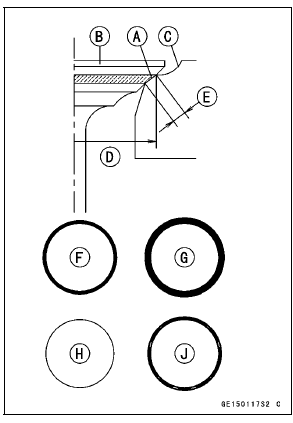

Measure the outside diameter [D] of the seating pattern on the valve seat.
If the outside diameter is too large or too small, repair the seat (see Valve Seat Repair).
Valve Seating Surface Outside Diameter Standard:
Exhaust 23.9  24.1 mm (0.941
24.1 mm (0.941
 0.949 in.)
0.949 in.)
Intake 30.4  30.6 mm (1.197
30.6 mm (1.197
 1.205 in.)
1.205 in.)

Measure the seat width [E] of the portion where there is no build-up carbon (white portion) of the valve seat with a vernier caliper.
Good [F]
If the width is too wide [G], too narrow [H] or uneven [J], repair the seat (see Valve Seat Repair).
Valve Seating Surface Width Standard:
Exhaust 0.8  1.2 mm (0.03
1.2 mm (0.03
 0.05 in.)
0.05 in.)
Intake 0.5  1.0 mm (0.02
1.0 mm (0.02
 0.04 in.)
0.04 in.)
 Valve-to-Guide Clearance Measurement (Wobble Method)
Valve-to-Guide Clearance Measurement (Wobble Method) Valve Seat Repair
Valve Seat RepairCheck 2-1: Speedometer Inspection
Using the suitable stand, raise the rear wheel off the
ground.
Rotate the rear wheel by hand or start the engine.
Check that the display changes speedometer.
If the display function does not work, check the following
parts.
Rear Wheel Rotation Sensor (see Wheel Rotation Sensor
Inspe ...
Spring Plate Free Play Measurement
Insufficient clutch free play will cause the engine braking
effect to be more sudden, resulting in rear wheel hop. On
the other hand, if the free play is excessive, the clutch lever
may feel “spongy” or pulsate when pulled.
Hold an extra drive shaft in a vise and install the following
c ...
Ignition System
WARNINGThe ignition system produces extremely
high voltage.
Do not touch the spark plug, ignition coil or ignition
coil lead while the engine is running, or you
could receive a severe electrical shock.
NOTICE
Do not disconnect the battery cables or any other
electrical ...